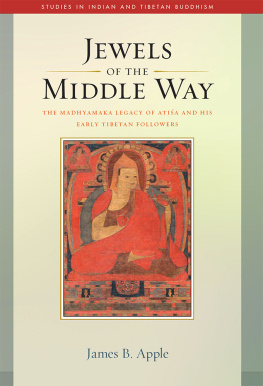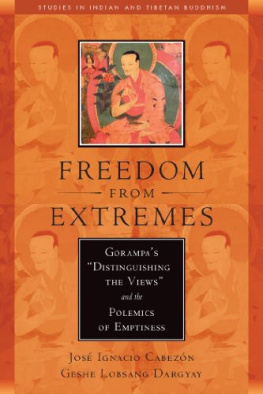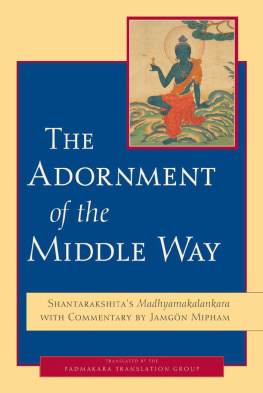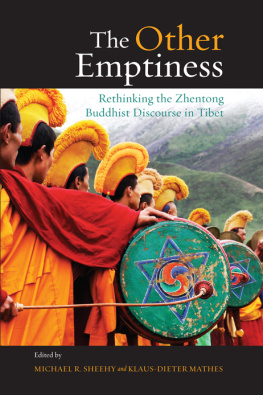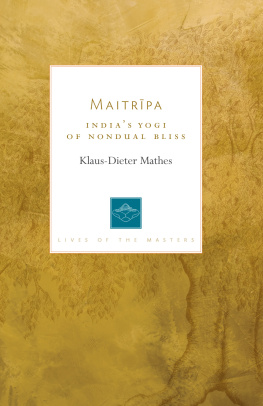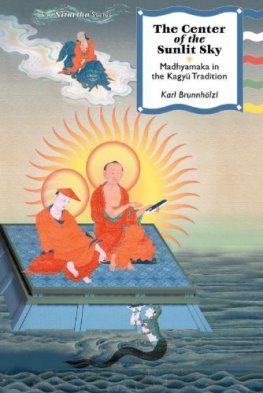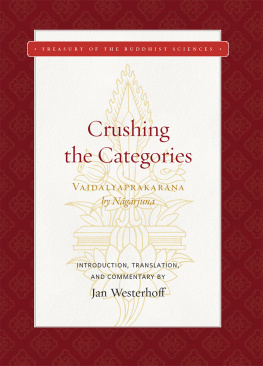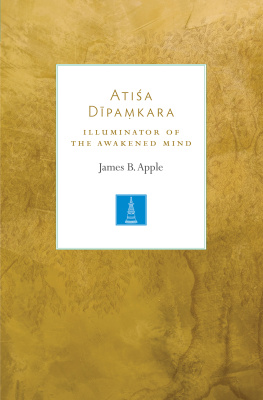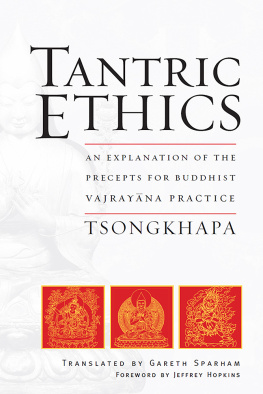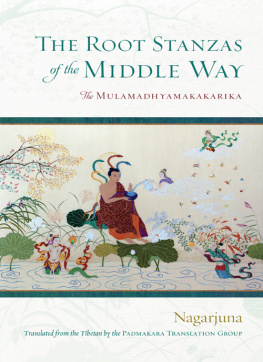Studies in Indian and Tibetan Buddhism
This series was conceived to provide a forum for publishing outstanding new contributions to scholarship on Indian and Tibetan Buddhism and also to make accessible seminal research not widely known outside a narrow specialist audience, including translations of appropriate monographs and collections of articles from other languages. The series strives to shed light on the Indic Buddhist traditions by exposing them to historical-critical inquiry, illuminating through contextualization and analysis these traditions unique heritage and the significance of their contribution to the worlds religious and philosophical achievements.
Members of the Editorial Board:
Tom Tillemans (co-chair), Emeritus, University of Lausanne
Jos Cabezn (co-chair), University of California, Santa Barbara
Georges Dreyfus, Williams College, Massachusetts
Janet Gyatso, Harvard University
Paul Harrison, Stanford University
Toni Huber, Humboldt University, Berlin
Shoryu Katsura, Ryukoku University, Kyoto
Thupten Jinpa Langri, Institute of Tibetan Classics, Montreal
Frank Reynolds, Emeritus, University of Chicago
Cristina Scherrer-Schaub, University of Lausanne
Ernst Steinkellner, Emeritus, University of Vienna
Leonard van der Kuijp, Harvard University

Wisdom Publications
199 Elm Street
Somerville, MA 02144 USA
wisdompubs.org
2018 James B. Apple
All rights reserved.
No part of this book may be reproduced in any form or by any means, electronic or mechanical, including photography, recording, or by any information storage and retrieval system or technologies now known or later developed, without permission in writing from the publisher.
Library of Congress Cataloging-in-Publication Data
Names: Apple, James B., author.
Title: Jewels of the middle way: the Madhyamaka legacy of Ata and his early Tibetan followers / James B. Apple.
Description: Somerville, MA: Wisdom Publications, 2018. | Series: Studies in Indian and Tibetan Buddhism | Includes bibliographical references and index. | Description based on print version record and CIP data provided by publisher; resource not viewed.
Identifiers: LCCN 2018009216 (print) | LCCN 2018036556 (ebook) | ISBN 9781614295013 (ebook) | ISBN 9781614294764 (pbk.: alk. paper)
Subjects: LCSH: Ata, 9821054 | BuddhismTibet RegionDoctrines. | Mdhyamika (Buddhism)
Classification: LCC BQ7950.A877 (ebook) | LCC BQ7950.A877 A67 2018 (print) | DDC 294.3/92092dc23
LC record available at https://lccn.loc.gov/2018009216
ISBN 978-1-61429-476-4 ebook ISBN 978-1-61429-501-3
22 21 20 19 18
5 4 3 2 1
Cover and interior design by Gopa & Ted2, Inc. Cover image: Portrait of the Indian monk Atisha. Courtesy of the Metropolitan Museum of Art. Gift of Steven Kossak, The Kronos Collections, 1993.
This book is dedicated to the memory of my spiritual teacher Gesh Lhundup Sopa (19232014), my mentor Leslie Kawamura (19352011), and my devoted colleague Jim Blumenthal (19672014) jewel-like teachers of the Middle Way.
Preface
G ESH LHUNDUP SOPA (19232014) enthusiastically introduced me to a biography of Atia in the early summer of 1992 while on retreat at Deer Park Buddhist Center outside of Oregon, Wisconsin. In the spring of 1996, Gesh Sopa led my graduate school classmates and I through Atias biography in a second-year classical Tibetan class at the University of Wisconsin-Madison. The following academic year we read Atias Open Basket of Jewels .
Over the summers from 1998 to 2002 at Deer Park Monastery in Oregon, Wisconsin, Gesh Sopa also introduced me to the Madhyamaka thought of Tsongkhapa (13571419) in seminars on the major worksthe Great Treatise on the Stages of the Path , the Essence of Eloquence , Elucidation of the Thought , and Ocean of Reasoning . I was intensely interested in Tsongkhapa, but could not help noticing that Atia was always only mentioned in passing in these works. In the back of my mind was the question, Did Atia have any sustained teachings or writing on Madhyamaka other than the Open Basket of Jewels ? That question was left unanswered for a number of years as I tried to gain stable employment as an academic scholar.
When I landed a tenure-track position at the University of Calgary in 2008, and having published a book related to Tsongkhapa ( Stairway to Nirva ), I noticed that a scholar in Japan, Izumi Miyazaki, had published a Tibetan critical edition of Atias Open Basket of Jewels , the Annotated Tibetan Text and Japanese Translation of the Ratnakaraodghamadhyamakopadea of Atia (2007). I immediately found my class notes from Gesh Sopas class, revised the English translation and annotation of Miyazakis paper, and published this in 2010 as Atias Open Basket of Jewels: A Middle Way Vision in Late Phase Indian Vajrayna. At the same time that I arrived at the University of Calgary, the availability of the the Collected Works of the Kadampas , unknown to Tibetan scholars after the seventeenth century and published in fascimiles only recently, had been announced.
Noticing that a number of the works were no longer extant elsewhere, I secured grant funds to acquire the Collected Works of the Kadampas in 2008. I can remember the day that the boxes arrived and my late, lamented mentor-colleague Leslie Kawamura (19352011) and I unpacked and shelved the first ninety volumes in my office. I was excited to see what these texts would say, particularly with regard to the Abhisamaylakra , on which the collection contained a number of commentaries. As a number of the works were written in hard-to-read cursive ( dbu med ) Tibetan script, I began to write down all the ligatures that I could not read.
Thanks to my training, I could read a majority of the texts, and over time and through comparison I was able to discern a number of abbreviations ( sdus yig ) and other scribal features of the texts that I wished to investigate. I began to notice several volumes on Madhyamaka whose authorship was considered anonymous. I analyzed, transcribed, and translated a number of them wherever and whenever I could find the time. In the spring of 2012, Shry Katsura arranged for me to present a lecture on An Early Tibetan Commentary on Atias Satyadvayvatra at the Ryukoku University Research Institute for Buddhist Cultures in Asia (BARC) in June 2012. In Kyoto preparing for the lecture, I realized that the volume A Collection of Special Instructions on the Middle Way in the Kadampa collection, the text that was the basis for the lecture, contained elements of Madhyamaka thought and practice I had not read before. I later revised and published this lecture in 2013, which became the basis for chapters 2 and 3 of this book. Upon returning to Canada, and interspersed among other research projects and publications from 2014 to 2016, I gradually edited and published the texts that would eventually become chapters 47.
I had every incentive to rework these articles into a book on the Madhyamaka thought and practice of Atia and his followers. Not only are the introductory essays and translations based on recently recovered Tibetan texts never before studied, but I was also motivated to counter the misperception of some modern scholars that Atia was not an important figure either in Indian or Tibetan Buddhist history. As the book demonstrates, this is decidedly not the case. I have also been motivated by a recent generation of scholars, particularly those who do not read Tibetan, who, with a disregard for sociohistorical context and philological precision, have tried to turn the profound spirituality of Indian and Tibetan Buddhist Madhyamaka into some type of analytical philosophy.

